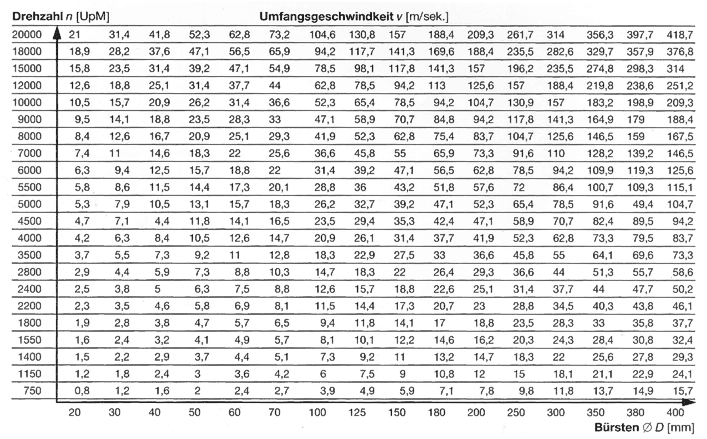FAQ
Brush wires
| wires | |
|
steel wire:
|
for processing metal surfaces |
|
twist knotted steel wire:
|
particular tough and aggressive |
|
crimped steel wire:
|
soft and flexible, aggressivity depends on wire strength |
|
stainless steel wire:
|
for cleaning stainless steel surfaces |
|
brass wire:
|
for cleaning delicate or brass surfaces |
|
filament grit:
|
for polishing, grinding and structuring from fine to medium grades |
table for rotational speeds
Rotational speed depends on rpm speed and brush diameter.

Problems occurring during work
| Problems occurring during work | |
| Brushing effect is not substantial enough: | 1.increase rotational speed by: a)using larger diameter b)increase rpm 2.use brush with shorter wire length 3.use brush with thicker material (e.g. use 0.35 wire instead of 0.30 or choose filament grit 120 instead of 180). |
| Brushing effect too substantial: | 1.decrease rotational speed by: a)using smaller diameter b)decrease rpm 2.use brush with longer wire length 3.use brush with less thickness (e.g. use 0.30 wire instead of 0.35 or choose filament grit 180 instead of 120). |
| Result is too coarse: | 1.increase rotational speed by: a)using larger diameter b)increase rpm 2.use brush with shorter wire length 3.use brush with thicker material(e.g. use 0.35 wire instead of 0.30 or choose filament grit 120 instead of 180). |
| Result is too sensitive: | 1.decrease rotational speed by: a)using smaller diameter b)decrease rpm 2.use brush with longer wire length 3.use brush with less thickness (e.g. use 0.30 wire instead of 0.35 or choose filament grit 180 instead of 120). |

